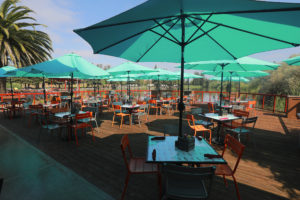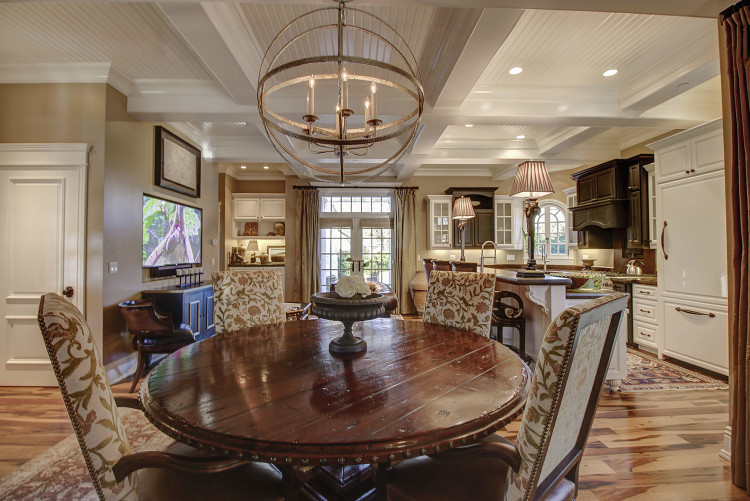Neoclassical busts, modern crystal sconces and abstract paintings are just a few components that come together in a renovated home just off the Sonoma plaza. The interior design scheme is the work of Íreko Interior Design & Fine Furniture in Santa Rosa. The home — framed by olive trees and with timeless details throughout — exemplifies the magic that comes from skillfully mixing contrasting elements.
Íreko co-founders Jim Rascoe and Michael Webb started out in 1985 with a small flower shop in downtown Santa Rosa. Soon, their services expanded into floral home design and, finally, interior design. 35 years later, the two now have a team, an expanded retail home store and design projects that range from condominiums to wineries to heritage homes.
Here, Rascoe shares some advice for home decorating, whether that’s with new furniture, old cherished pieces or a mix of both. He has several tips for creating a well-designed interior. But one of his best tips centers on what not to do.
Design for your unique space and tastes
“The ultimate mistake is to invite your neighbor to give the final call on what you want to do with your own house,” says Rascoe. “Getting advice is great, but it’s your space. If you love it, it’s probably okay.”
This advice encapsulates a central tenet of Rascoe’s interior design philosophy: homes should be functional and comfortable, and also suit individual tastes and preferences rather than trends. This means avoiding replicating rooms featured in catalogs and stores. What might look great in marketing photos won’t work in every home.
“Your house doesn’t have 20-foot ceilings, French doors, steel case windows (like the rooms in magazines). There’s no one way to treat all rooms,” he says.
As people want to make “safe” choices, they copy interiors from magazines and online and pick pieces that will coordinate easily. Rascoe works against this pervasive uniformity in home design.
“It’s all going to work great, but it’s all boring and unexciting,” he says. Instead, he prefers to mix old with new, ornate with modern. “Accessories show your character,” he adds. “This is your opportunity to “transform something from ho-hum to ‘oh wow.'”
Start with large pieces
Rascoe employs a particular foundational tactic to achieve a great look. “I’ve come to the conclusion that everything about interiors hinges on scale,” he says.
He suggests starting with the biggest most functional pieces (like sofas, tables and TV furniture) and, once the larger pieces are in place, smaller objects, accents and decorative pieces can fill the spaces that call for them. Feel free to move large pieces around to find a sense of balance that’s both functional and pleasing to the eye: A TV might sit across from a sofa. A reading nook might fill in a corner.
Rascoe encourages investing in a few good pieces like upholstery, tables, lamps or art. “Those can be reinvented a million and one ways,” he says. “You will always find a home for great things. Great pieces last forever.”
The Santa Rosa designer also believes in using what you already own.
While some might hesitate to put an ornate piece in an otherwise modern room, Rascoe says, “It is that touch of something with a history that will create the most exciting contemporary look.” Add pieces that are unique and personal and “see them in a way you’ve never seen them before.”
But don’t add too many small things to a room. Collections tend to make a room feel cluttered, while large objects don’t usually have that effect on a space, says Rascoe.
Use light as an accessory
In addition to creating visibility for performing tasks and moving around the house, pools of light can be interesting focal points. Rascoe likes to use light as an accessory — it can be atmospheric, exciting and dramatic. He enjoys viewing spaces with lighting done well — (they) are so exciting to visit at night,” he says.
There’s no need to do a massive rewiring project to add more interesting light sources to your home.
“Most builders want to punch can lights (in ceilings),” says Rascoe and adds, “The fewer of those kind of lights, the better off you are. You’re not living in a grocery store. You’re living in a residence.”
Instead, add a well-designed reading light, floor lamp or table lamp, which will also serve as accents. Rascoe also suggests adding dimmers to lights so that the mood of the room can be controlled with a simple slide on the switch.
Look for new ways to use familiar pieces
Rascoe has made lamps out of china and fashioned side tables from antique Japanese screens. These pieces can become focal points in any room by highlighting the beauty of antique or vintage materials. Visits to antique stores, salvage yards and estate sales can be the inspiration for accents that are truly unique.
The Santa Rosa designer always moves around furniture and decor in his own home. A living room chair might get moved to the bedroom to go with an ottoman. Such movements can reinvent pieces and give the owner renewed appreciation for them.
Among Rascoe’s most treasured pieces is a table made by award-winning designer Paul Maitland-Smith. The top of the rustic table is woven copper and the base is bronze. Every day, Rasco thinks to himself, “My God. It’s a totally singular piece of furniture. It doesn’t get better than that.”
It’s a crown jewel in a space that epitomizes Rascoe’ design philosophy, “The same room has never been done twice and never will be done again.”





















